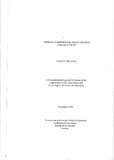| dc.contributor.advisor | Yannas, Simos | |
| dc.contributor.advisor | Ford, Brian | |
| dc.contributor.author | Mallick, Fuad H. | |
| dc.date.accessioned | 2014-06-26T05:17:26Z | |
| dc.date.available | 2014-06-26T05:17:26Z | |
| dc.date.copyright | 1994 | |
| dc.date.issued | 1994-09 | |
| dc.identifier.uri | http://hdl.handle.net/10361/3356 | |
| dc.description | This thesis submitted in partial fulfilment of the requirements of the Open University for the degree of Doctor of Philosophy, 1994. | |
| dc.description | Cataloged from PDF version of thesis report. | |
| dc.description | Includes bibliographical references (page 267). | |
| dc.description.abstract | The existence of a thermally comfortable domestic living environment is important for a
healthy and productive life. In Bangladesh, the use of artificial means of environmental
control to achieve indoor comfort is not viable for reasons of increased energy costs vis a
vis national economy. The problem has to be addressed through appropriate design of
buildings that promote thermal comfort through its natural interaction with the outdoor
environment. This thesis focuses on indoor comfort in urban housing, present day trends in the design of which often result in indoor conditions which are overheated for a major part of the year. This is through two main areas of concern. Firstly, the determination of environmental conditions that are percieved as comfortable by the occupants of such housing, secondly the ability of different kinds of urban houses to meet these conditions.
The inquiry on thermal comfort draws from the results of a field survey carried out with
occupants of urban housing where the environmental variables that correspond to different
thermal sensations were recorded over a period of time. The analysis identifies the range of
conditions that are percieved as comfortable by most of the people' These conditions are
then compared with thermal data from different types of urban houses recorded in them for short periods in the three different seasons and also with the occupants general opinions on comfort in their own houses. Comparisons between different houses are made to identify design features that influence thermal behaviour and contribute to comfort. These features are used as a basis for computer based parametric studies using the thermal simulation programme SPIEL to evaluate the isolated effects of each'
The conclusions are concerned with design features in urban houses which promote indoor comfort. The results of the analysis identifies considerations pertaining to choice of site, building construction, orientation, and exposure of surfaces as the primary material' The resulting recommendations that are a function of design tasks also include means that may be adopted to promote passive cooling. | en_US |
| dc.format.extent | 268 pages | |
| dc.language.iso | en | en_US |
| dc.publisher | Open University | en_US |
| dc.subject | Urban housing | |
| dc.title | Thermal comfort for urban housing in Bangladesh | en_US |
| dc.type | Thesis | |
| dc.contributor.department | Department of Architecture, BRAC University | |

